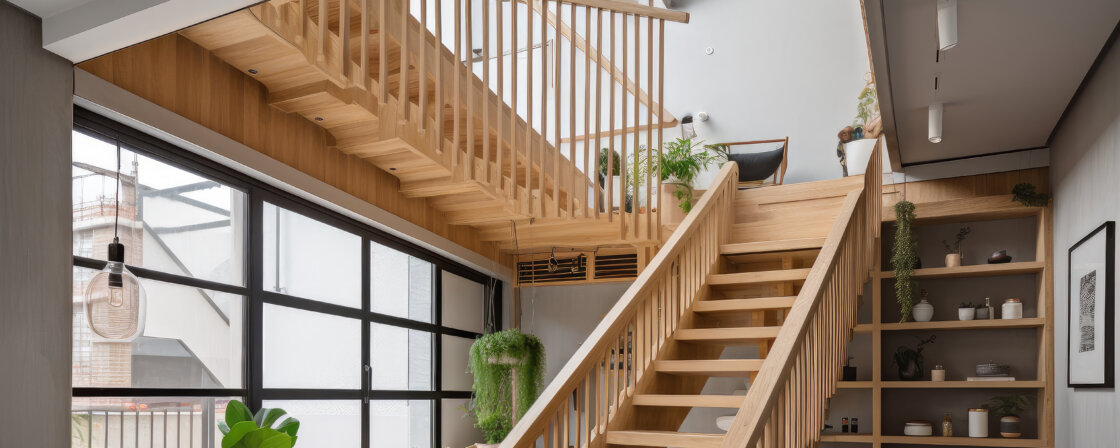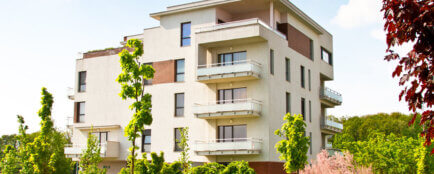What is a duplex apartment
A maisonette is a type of apartment that occupies two or more floors in a building. In a duplex apartment, the lower floor usually contains common living areas such as the living room and kitchen while the upper floor tends to contain bedrooms, study etc., thus separating the common living areas from the private ones. In our conditions, duplex flats are usually created by joining two flats above each other, by attaching a loft space to the upper flat or by adding an extension on the flat roof of the apartment building.
Advantages and disadvantages of a duplex apartment
Duplex flats can be tempting because of their unusualness and large space. However, you should consider certain factors before opting for this type of flat. Therefore, we bring you the main advantages and disadvantages of a duplex apartment.
Advantages
- Use of space: duplex apartments make efficient use of limited space on the ground (especially in densely populated cities). This allows the occupants to get more space in the same area.
- Separation of living space: dividing common and private areas into two floors provides more privacy.
- Airiness: duplexes tend to be more airy and sunny than traditional single-storey apartments.
Disadvantages
- Accessibility: Maisonettes are not suitable for people with physical limitations or for those for whom the division of stairs could complicate their daily functioning. Therefore, these types of apartments are usually not suitable for the elderly or families with young children.
- Temperature imbalance: duplexes can have the problem of heat imbalance. For example, in a situation where the upper floor is the attic of the apartment building and therefore there is heat build-up from the roof while cold air remains below.
- Cost: In general, duplexes tend to be more expensive to acquire, build and maintain compared to single storey dwellings.
- Resale issues: There may be a problem in selling a duplex apartment. This is because it is a specific type of apartment that is not for everyone and therefore you may have fewer buyers when selling it than a conventional apartment.
Tip for article
Wondering how to buy a mortgage-financed home? Then you must not miss our next article, in which you will learn the conditions for obtaining a mortgage.
For sale duplex apartment
Duplex flats are sold in the same way as classic one-storey flats. So if you’re after a maisonette, you’ll need to keep looking. Some online portals offering apartments for rent or sale, such as Sreality.cz, can make this search easier thanks to their filtering system. It is on the aforementioned Sreality that you can filter atypical apartments. Thanks to this option, you can search not only for duplex apartments, but also for basement or attic apartments. In addition to buying a ready-made duplex apartment, there is also the possibility to build this type of apartment. There are two main ways – joining two flats together and joining a flat with a loft.
Are you solving a similar problem?
Are you planning to buy or build a duplex?
We will provide you with a complete contractual and legal service. We can do it within 48 hours, flawlessly and professionally.
- When you order, you know what you will get and how much it will cost.
- We handle everything online or in person at one of our 6 offices.
- We handle 8 out of 10 requests within 2 working days.
- We have specialists for every field of law.
Connecting two apartments together
One of the ways to get a duplex is to buy two flats above each other, which you connect with a staircase. However, this isn’t just any way to do it, and if you actually decide to do this, there’s a lot of paperwork to deal with:
Co-op or HOA?
If you are a member of a housing association, you will need its approval to renovate. If you have a freehold flat, you don’t need the approval of the HOA. However, the exception is if you would be interfering with the common parts of the house, i.e. the wiring, etc. In any case, it is a courtesy to tell your neighbours that you are going to renovate and ask them to tolerate the increased noise level. In addition, it is also a good idea to give them an estimate of the time you will spend on the renovation.
If you are part of a unit owners’ association, you cannot avoid changing the owner’s declaration. This is the document that divides the ownership of the condominium into individual lots (apartments). When you build a duplex, two such units are joined together to form one unit. Therefore, it is necessary to include this change in the owner’s declaration. This change also gives you a higher ownership share in the common parts of the building. However, you will also have to make larger contributions to the repair fund.
Tip for article
Tip: Are you a member of the committee of a condominium or the board of directors of a housing cooperative? Are you dealing with the owners or members of the cooperative to merge two apartments and do not know what to do? Or do you believe that someone has chosen the wrong legal procedure against you? Arrange with us to represent you at a meeting of owners or members of a condominium association.
Execution of the building permit
Next comes the building permit. You will need this if you are going to interfere with the supporting structures, if the modifications will adversely affect the safety of the building or if you plan to use unusual materials that differ in weight from the original materials.
In these cases, you will need to submit documentation of the planned renovation to the building authority , drawn up by a specialist. If you have a condominium, the condominium as a whole applies for a building permit.
In other cases, a building notice will always be required when joining two flats together. This has a big advantage over planning permission in that it is quicker to process. However, the disadvantage is that you will need the consent of all the people concerned. Your neighbours will therefore have to agree to the renovation. If only one of the neighbours does not agree, the building notice is converted into a building permit and the whole process is delayed.
Common parts of the house and the maisonette
When converting a flat into a duplex or adding a loft, you will often come across the issue of use and interference with the common parts of the house, such as risers, chimneys or the roof. Although these parts physically pass through a particular dwelling unit, they legally belong to all the owners of the house together. Therefore, any intervention in them – relocation, extension, connection, discharge – requires the consent of the unit owners’ association (HOA) and often also technical documentation or revisions according to the relevant standards.
For example, risers for water, gas or electricity are considered common services. If you need to introduce a new line into the apartment or extend an existing line into a new part of the apartment, you must submit a project that ensures that the function for the other units will not be compromised. Similarly, a chimney flue is considered common unless it exclusively serves a single unit. When installing a fireplace or boiler, you need to provide evidence of a flue inspection and discuss the procedure with the HOA. Chimneys are a common cause of disagreement, especially if their capacity does not allow other appliances to be connected.
A specific chapter is access to the roof, which is often needed both during the construction and later during maintenance, installation of skylights or revisions. If the roof is not freely accessible, it is usually dealt with contractually as a right of access or as part of the construction agreement. Even if the land is physically connected to the dwelling, the owner does not have an automatic right to use, alter or place equipment (e.g. air conditioning, photovoltaics) on the roof without the consent of others.
From a legal perspective, it is therefore crucial to have everything negotiated and documented with the written consent of the HOA. Not only for the sake of the construction procedure, but also as protection against future disputes, especially if the community changes its circumstances or ownership structure.
Tip for article
Tip: Applying for a building permit can be a nightmare. Find out what you need to do and where, and what you can expect if you don’t get the right permit and decide to build in the dark.
Flats in conservation care
If the flats you are converting are listed or directly in a listed building, the whole process will be a little more complicated. This is because the conservation officers are also involved in the process, and they can tell you what materials you can and cannot use, how to proceed with the renovation , and so on. It’s also not impossible that they will ban you from building a duplex altogether. Therefore, it is better to find out about these possibilities well in advance.
Tip for article
Tip: Getting a building permit and dealing with conservation officers can often be complicated for the layperson. Leave it to us. We work quickly, online and reliably.
Change at the Land Registry
After the construction modifications and possible processing of the change of use of the building, it is also advisable to proceed to the adjustment of the legal status at the Land Registry. If there were originally two separately registered residential units, they can be merged into one unit in the Land Registry after merging into one duplex. To do this, it is necessary to prepare an amendment to the owner’s declaration (in the case of apartment buildings), which is approved by the owners’ assembly, and submit it together with a geometric plan and other annexes to the cadastral office. The merger itself is not technically impossible, as is sometimes claimed – but it is a more administratively and legally demanding process, which is often not carried out if both units remain in the ownership of one person. In the long run, however, it is preferable to have the status regulated in the Land Registry – for the sake of sales, taxes and legal clarity.
Tip for article
Tip: Are you about to file a petition for entry into the Land Registry? We will help you with the drafting of the application so that everything is in order the first time and you do not miss important deadlines or lose money.
Connection of the apartment with the attic
If you own a top floor apartment and would like to combine it with the attic, the procedure will be similar to combining two apartments. However, there will be a few differences. First of all, you need to remember that the attic usually belongs to the common areas of the house and therefore all the owners of the flats are the owners. You will therefore have to get their consent and probably have to pay them (the exact rules should be contained in the statutes).
You will also need to enter into a development agreement. This is because the conversion of the loft will create an additional dwelling unit in the apartment building. This agreement must be signed by all the owners of the flats and unfortunately you cannot do without it. In the case of the conversion of land that is already a separate unit, it is a change of use and its conversion. If the land is not yet registered as a unit, then a development agreement is required.
When converting land, you also cannot avoid the need to obtain a building permit. This is because in this case there is interference with the structure of the house. You will therefore also need to provide a certificate from a structural engineer. In addition, you will have to report the change of use of the building to the building authority, i.e. the change from land to living space. You will then have to have the loft space approved once the building is completed.
The whole process of building a maisonette can be challenging, but with careful preparation and following all legal and building procedures, it is fully achievable. In the end, your new duplex apartment can give you exactly what you’ve been looking for – plenty of space, airiness and uniqueness.
📄 What you need for the merger of housing units in the cadastre
- ✍️ Change of building owner’s declaration (must be approved by the owners’ meeting, unless you are the sole owner of all the units),
- 📐 Geometric plan if there is a change in the extent of the area or floor plan,
- 🏗️ Construction documents and, if applicable, the building approval (if major modifications have taken place),
- 📎 Proposal for entry into the Land Registry,
- 📄 Consent of the HOA (or cooperative) if you are encroaching on the common parts of the house.




